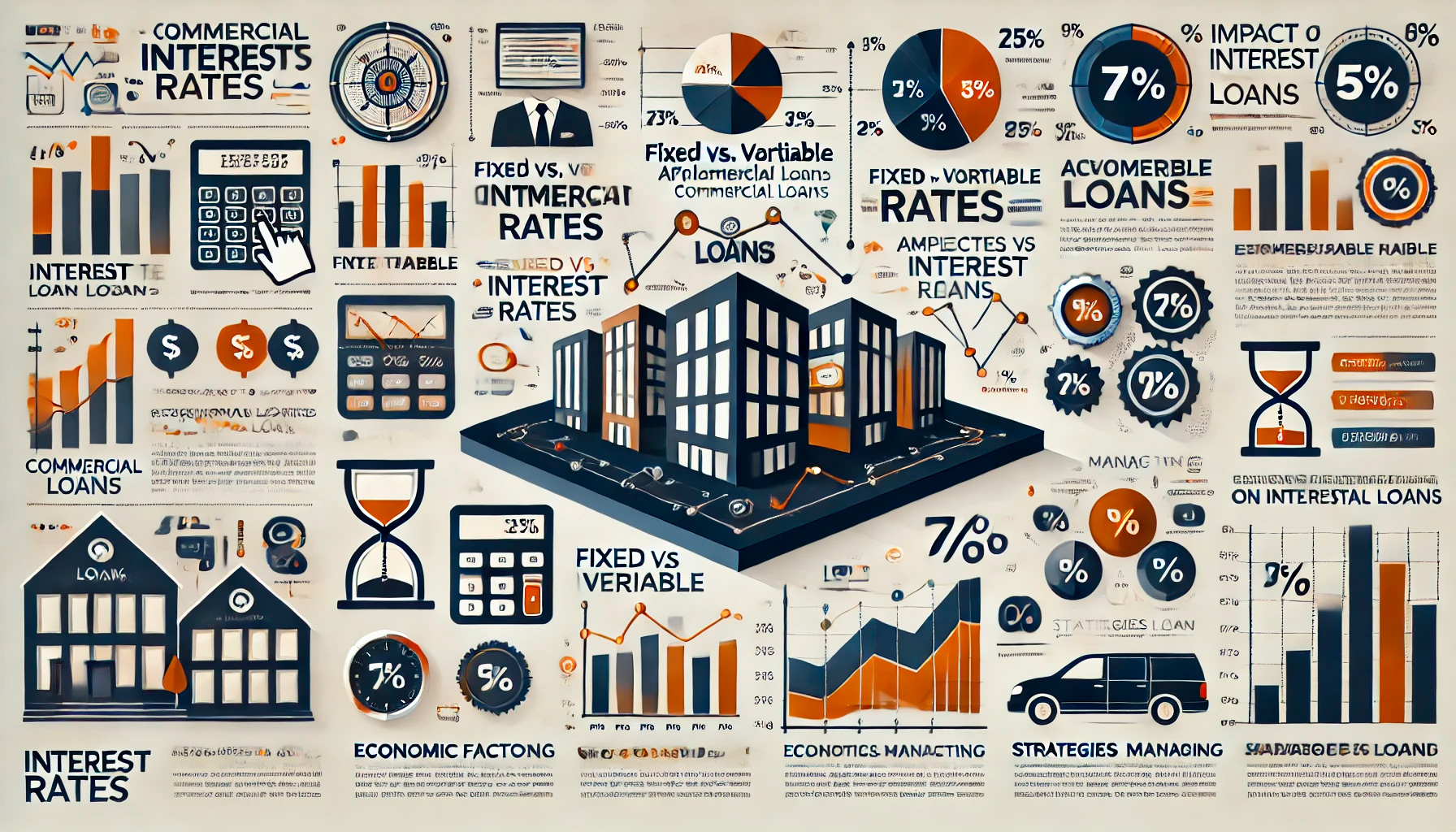
The Impact of Interest Rates on Commercial Loans: What Business Owners Need to Know
Interest rates are one of the most significant factors affecting the cost and accessibility of commercial loans. For business owners, understanding how interest rates influence loan terms, repayment obligations, and overall financial strategy is critical. Whether rates are rising, stable, or declining, their impact can shape borrowing decisions and long-term business planning.
This guide explores the relationship between interest rates and commercial loans, offering insights to help business owners make informed decisions and optimize their financial outcomes.
How Interest Rates Affect Loan Costs
The interest rate on a commercial loan determines the cost of borrowing. It is the percentage of the loan amount that a borrower must pay in addition to the principal. Even small changes in interest rates can significantly affect the total repayment amount over the life of a loan.
For example, a higher interest rate results in larger monthly payments and increases the overall cost of the loan. Conversely, lower rates reduce monthly obligations, freeing up cash flow for other business expenses. Business owners must carefully evaluate how interest rates align with their budget and financial goals before committing to a loan.
Fixed vs. Variable Interest Rates
When choosing a commercial loan, borrowers often decide between fixed and variable interest rates. Each option comes with distinct advantages and challenges.
Fixed Interest Rates
Fixed rates remain consistent throughout the loan term, providing predictability and stability. This makes them ideal for businesses that prefer steady monthly payments and want to avoid the uncertainty of rate fluctuations. However, fixed rates are often higher than introductory rates offered by variable loans.
Variable Interest Rates
Variable rates fluctuate based on market conditions and are tied to an index, such as the prime rate or LIBOR. While they can start lower than fixed rates, they carry the risk of increasing over time, potentially leading to higher payments. Variable rates are suited for businesses with strong cash flow that can accommodate potential rate increases.

The Role of Economic Factors
Interest rates are influenced by various economic factors, including inflation, central bank policies, and overall economic growth. When central banks, such as the Federal Reserve, adjust their benchmark rates, the cost of borrowing changes for lenders, which in turn affects commercial loan rates.
- Inflation: High inflation often leads to higher interest rates as central banks attempt to control price increases.
- Economic Growth: In periods of strong economic growth, demand for loans rises, which can drive interest rates higher.
- Monetary Policy: Central banks may raise or lower rates to stimulate or cool down the economy, directly impacting commercial loan rates.
Understanding these factors helps business owners anticipate rate changes and plan their borrowing strategies accordingly.
Interest Rates and Loan Types
The type of commercial loan you choose also affects how interest rates are applied and their impact on your business.
- Term Loans: These loans often come with fixed rates, providing stability for long-term investments.
- Lines of Credit: Lines of credit typically feature variable rates, making them sensitive to market fluctuations.
- SBA Loans: Small Business Administration loans usually offer competitive fixed or variable rates, influenced by government policies.
- Equipment Financing: Rates for equipment loans depend on the lender and the type of equipment purchased, often featuring competitive fixed rates.
Selecting the right loan type ensures that your borrowing aligns with your financial goals and your ability to manage interest-related risks.
Strategies for Managing Interest Rate Impact
To minimize the impact of interest rates on your commercial loan, consider the following strategies:
- Timing Your Loan: Borrow during periods of low interest rates to secure favorable terms and reduce the overall cost of borrowing.
- Locking in Fixed Rates: If rates are expected to rise, locking in a fixed rate ensures predictable payments and shields your business from future increases.
- Refinancing Existing Loans: When rates drop, refinancing an existing loan at a lower rate can reduce monthly payments and save money over time.
- Building Strong Credit: A higher credit score often qualifies businesses for better rates, lowering the cost of borrowing.
By actively managing interest rate risks, businesses can protect their financial health and maintain stability.
The Impact on Cash Flow
Interest rates directly influence a business’s cash flow, affecting its ability to cover operational expenses, invest in growth, and meet financial obligations. High interest rates can strain cash flow by increasing monthly payments, leaving less room for other priorities. Conversely, low rates enhance liquidity, allowing businesses to allocate resources more freely.
For businesses with variable-rate loans, cash flow management becomes even more critical. Preparing for potential rate increases ensures that your business can weather fluctuations without compromising operations or profitability.
Planning for Rate Fluctuations
Economic conditions can change unexpectedly, leading to shifts in interest rates. Business owners must adopt proactive measures to prepare for these fluctuations:
- Scenario Analysis: Model different rate scenarios to understand their potential impact on your loan repayments and overall budget.
- Maintaining Reserves: Build a financial cushion to manage higher payments if rates rise unexpectedly.
- Consulting Financial Advisors: Work with experts to develop strategies that align with your business’s financial goals and risk tolerance.
Planning for rate changes positions your business to adapt and thrive, regardless of economic conditions.
The Long-Term View
While interest rates are an important factor in borrowing decisions, they should be considered within the broader context of your business goals. A slightly higher interest rate might be acceptable if the loan enables a high-return investment, such as expanding into new markets or purchasing revenue-generating equipment.
Conversely, a low-rate loan that doesn’t align with your strategy could lead to missed opportunities or unnecessary financial strain. Evaluating loans holistically ensures that your borrowing supports your long-term vision.
Conclusion: Navigating Interest Rates with Confidence
Interest rates are a critical component of commercial loans, shaping their cost, repayment terms, and overall impact on your business. By understanding how rates work and planning strategically, you can make informed decisions that align with your financial objectives.
Whether you’re considering a fixed or variable-rate loan, timing your borrowing to market conditions, or preparing for potential fluctuations, a proactive approach ensures that interest rates work in your favor. With careful planning and thoughtful management, commercial loans become a powerful tool for achieving growth, stability, and success in today’s dynamic business environment.
